Yield and Revenue Management: A Business Intelligence Review
VerifiedAdded on 2023/06/03
|5
|1175
|263
Report
AI Summary
This report examines yield and revenue management, focusing on how businesses, particularly hotels, utilize business intelligence firms like IDeaS to optimize revenue. The report highlights the challenges hotels face in pricing and distribution, and how IDeaS provides cloud-based solutions that automate pricing and improve revenue performance. It explores how senior management can leverage IDeaS's analytical capabilities to make informed decisions, adapt to market changes, and improve their competitive advantage. The analysis covers pricing strategies, market segmentation, channel management, and the importance of understanding competitor data. The report emphasizes the benefits of automated decision-making, improved forecasting, and the ability to attract different customer segments, ultimately leading to increased profitability and market share. The report also references several sources to support the points discussed.
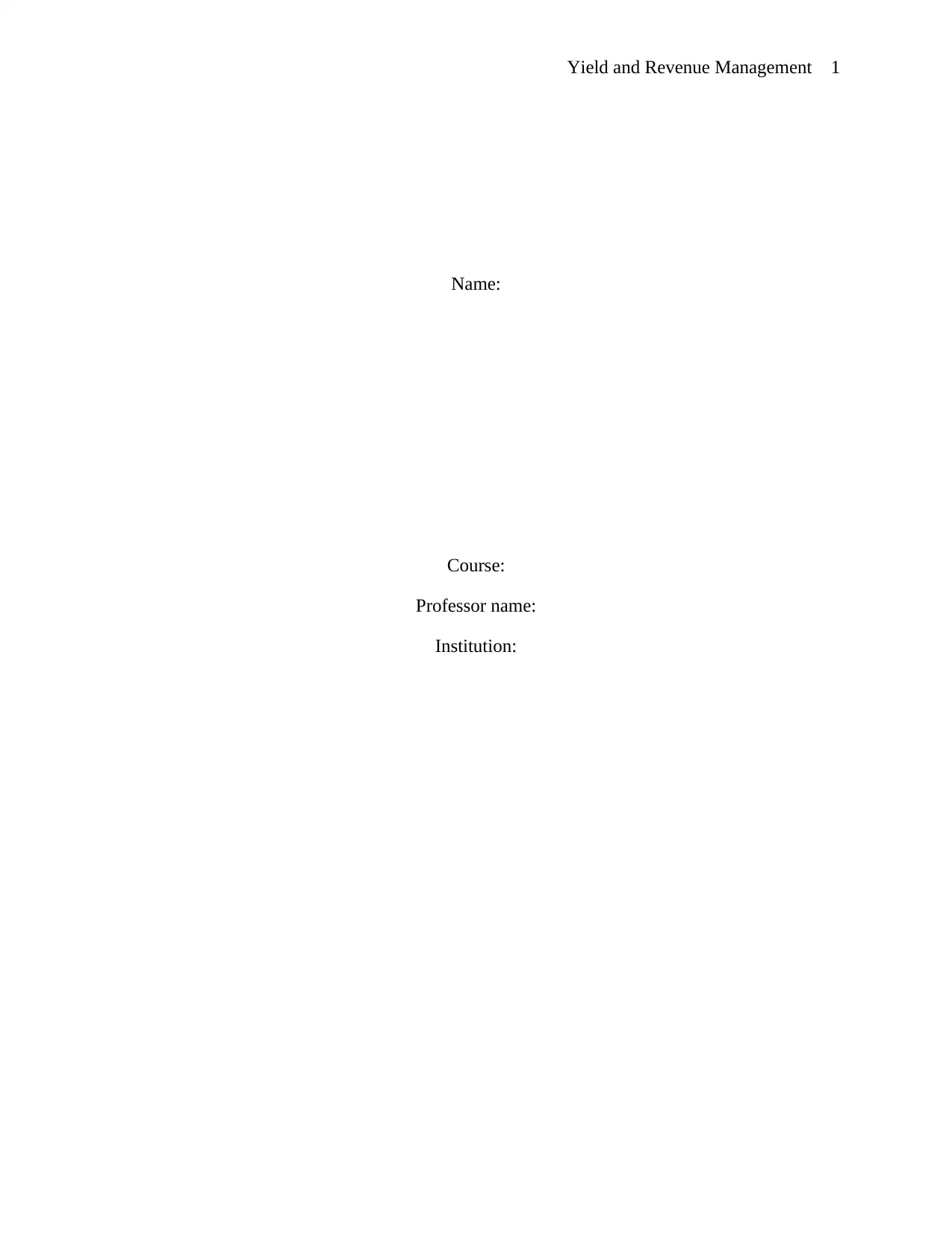
Yield and Revenue Management 1
Name:
Course:
Professor name:
Institution:
Name:
Course:
Professor name:
Institution:
Paraphrase This Document
Need a fresh take? Get an instant paraphrase of this document with our AI Paraphraser
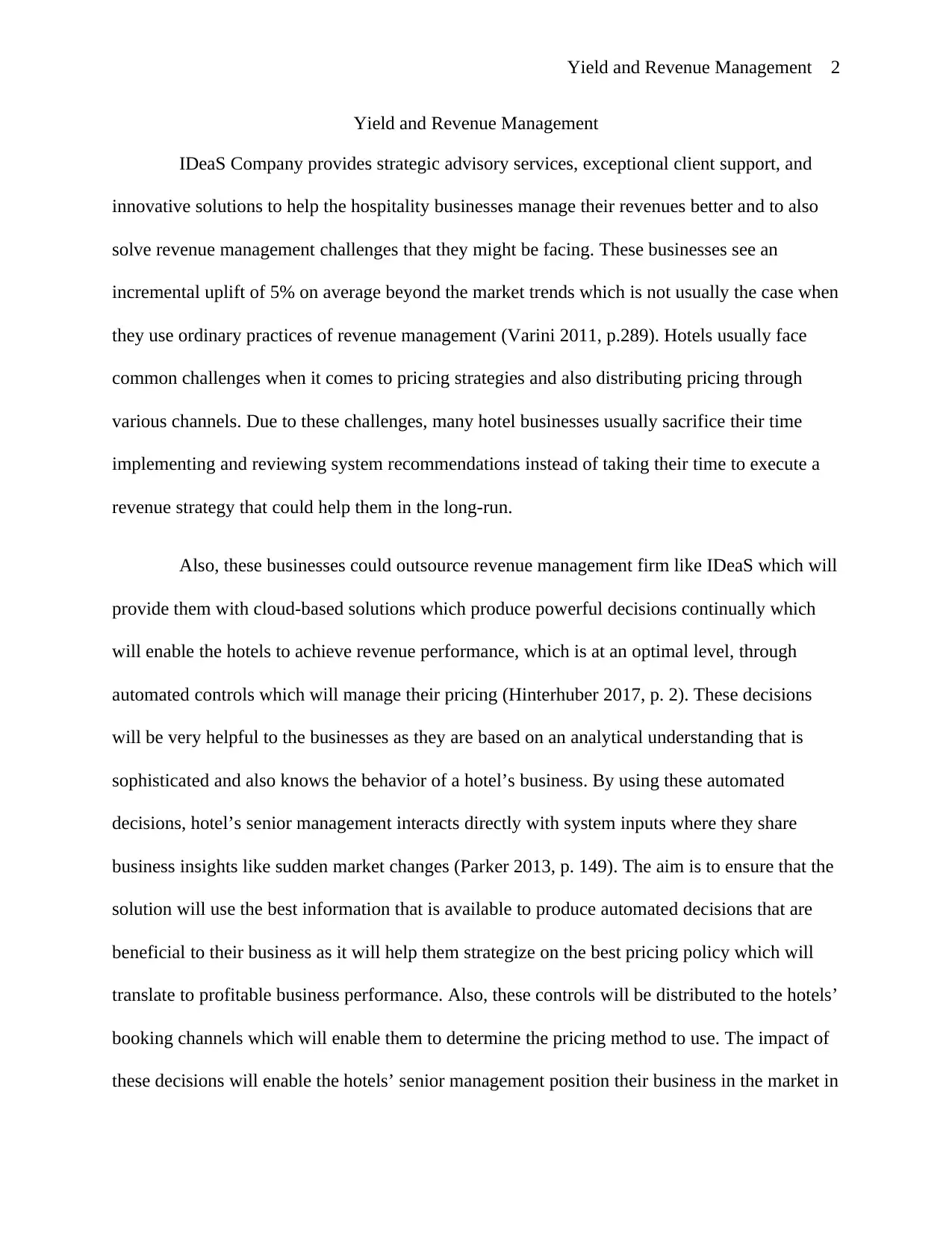
Yield and Revenue Management 2
Yield and Revenue Management
IDeaS Company provides strategic advisory services, exceptional client support, and
innovative solutions to help the hospitality businesses manage their revenues better and to also
solve revenue management challenges that they might be facing. These businesses see an
incremental uplift of 5% on average beyond the market trends which is not usually the case when
they use ordinary practices of revenue management (Varini 2011, p.289). Hotels usually face
common challenges when it comes to pricing strategies and also distributing pricing through
various channels. Due to these challenges, many hotel businesses usually sacrifice their time
implementing and reviewing system recommendations instead of taking their time to execute a
revenue strategy that could help them in the long-run.
Also, these businesses could outsource revenue management firm like IDeaS which will
provide them with cloud-based solutions which produce powerful decisions continually which
will enable the hotels to achieve revenue performance, which is at an optimal level, through
automated controls which will manage their pricing (Hinterhuber 2017, p. 2). These decisions
will be very helpful to the businesses as they are based on an analytical understanding that is
sophisticated and also knows the behavior of a hotel’s business. By using these automated
decisions, hotel’s senior management interacts directly with system inputs where they share
business insights like sudden market changes (Parker 2013, p. 149). The aim is to ensure that the
solution will use the best information that is available to produce automated decisions that are
beneficial to their business as it will help them strategize on the best pricing policy which will
translate to profitable business performance. Also, these controls will be distributed to the hotels’
booking channels which will enable them to determine the pricing method to use. The impact of
these decisions will enable the hotels’ senior management position their business in the market in
Yield and Revenue Management
IDeaS Company provides strategic advisory services, exceptional client support, and
innovative solutions to help the hospitality businesses manage their revenues better and to also
solve revenue management challenges that they might be facing. These businesses see an
incremental uplift of 5% on average beyond the market trends which is not usually the case when
they use ordinary practices of revenue management (Varini 2011, p.289). Hotels usually face
common challenges when it comes to pricing strategies and also distributing pricing through
various channels. Due to these challenges, many hotel businesses usually sacrifice their time
implementing and reviewing system recommendations instead of taking their time to execute a
revenue strategy that could help them in the long-run.
Also, these businesses could outsource revenue management firm like IDeaS which will
provide them with cloud-based solutions which produce powerful decisions continually which
will enable the hotels to achieve revenue performance, which is at an optimal level, through
automated controls which will manage their pricing (Hinterhuber 2017, p. 2). These decisions
will be very helpful to the businesses as they are based on an analytical understanding that is
sophisticated and also knows the behavior of a hotel’s business. By using these automated
decisions, hotel’s senior management interacts directly with system inputs where they share
business insights like sudden market changes (Parker 2013, p. 149). The aim is to ensure that the
solution will use the best information that is available to produce automated decisions that are
beneficial to their business as it will help them strategize on the best pricing policy which will
translate to profitable business performance. Also, these controls will be distributed to the hotels’
booking channels which will enable them to determine the pricing method to use. The impact of
these decisions will enable the hotels’ senior management position their business in the market in
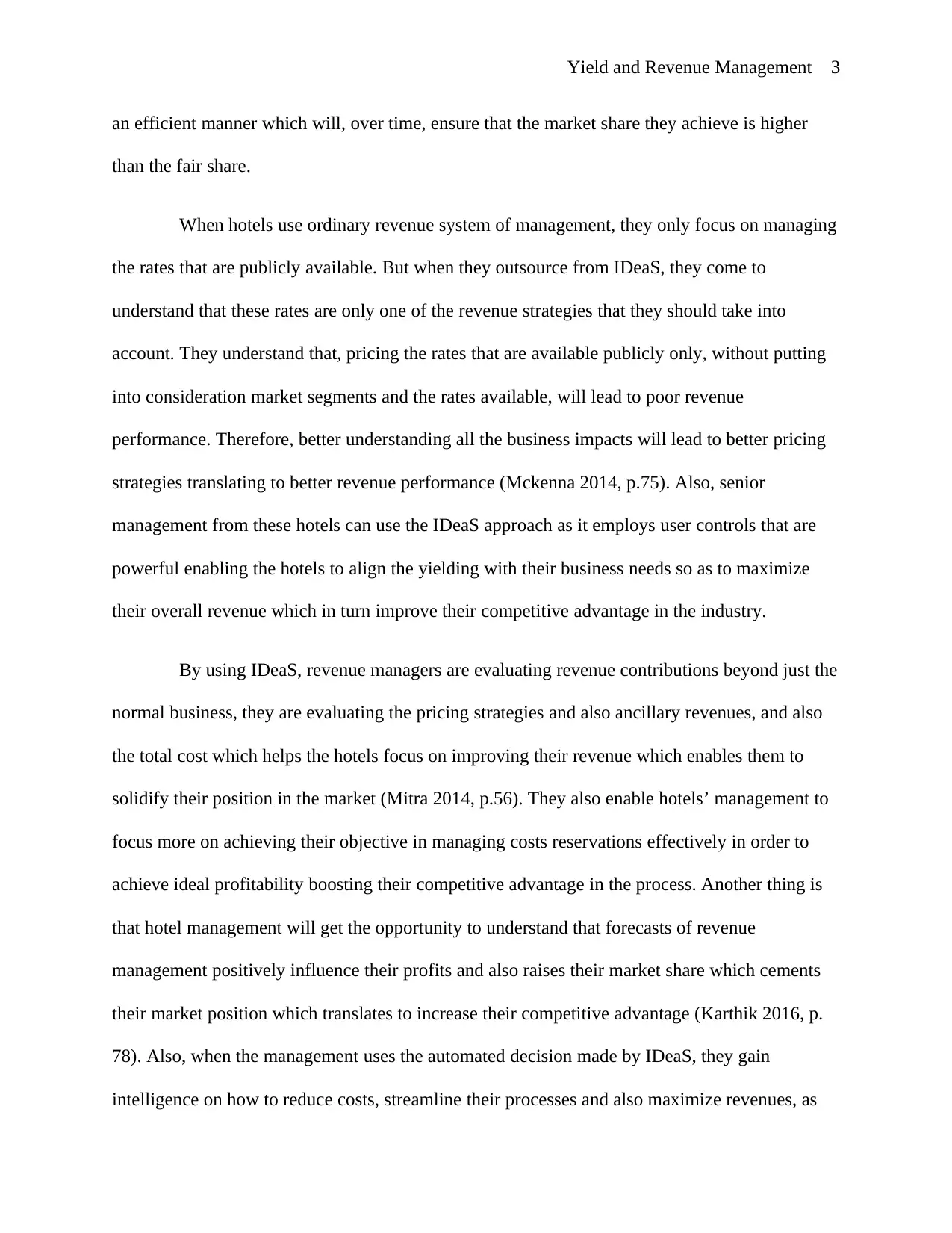
Yield and Revenue Management 3
an efficient manner which will, over time, ensure that the market share they achieve is higher
than the fair share.
When hotels use ordinary revenue system of management, they only focus on managing
the rates that are publicly available. But when they outsource from IDeaS, they come to
understand that these rates are only one of the revenue strategies that they should take into
account. They understand that, pricing the rates that are available publicly only, without putting
into consideration market segments and the rates available, will lead to poor revenue
performance. Therefore, better understanding all the business impacts will lead to better pricing
strategies translating to better revenue performance (Mckenna 2014, p.75). Also, senior
management from these hotels can use the IDeaS approach as it employs user controls that are
powerful enabling the hotels to align the yielding with their business needs so as to maximize
their overall revenue which in turn improve their competitive advantage in the industry.
By using IDeaS, revenue managers are evaluating revenue contributions beyond just the
normal business, they are evaluating the pricing strategies and also ancillary revenues, and also
the total cost which helps the hotels focus on improving their revenue which enables them to
solidify their position in the market (Mitra 2014, p.56). They also enable hotels’ management to
focus more on achieving their objective in managing costs reservations effectively in order to
achieve ideal profitability boosting their competitive advantage in the process. Another thing is
that hotel management will get the opportunity to understand that forecasts of revenue
management positively influence their profits and also raises their market share which cements
their market position which translates to increase their competitive advantage (Karthik 2016, p.
78). Also, when the management uses the automated decision made by IDeaS, they gain
intelligence on how to reduce costs, streamline their processes and also maximize revenues, as
an efficient manner which will, over time, ensure that the market share they achieve is higher
than the fair share.
When hotels use ordinary revenue system of management, they only focus on managing
the rates that are publicly available. But when they outsource from IDeaS, they come to
understand that these rates are only one of the revenue strategies that they should take into
account. They understand that, pricing the rates that are available publicly only, without putting
into consideration market segments and the rates available, will lead to poor revenue
performance. Therefore, better understanding all the business impacts will lead to better pricing
strategies translating to better revenue performance (Mckenna 2014, p.75). Also, senior
management from these hotels can use the IDeaS approach as it employs user controls that are
powerful enabling the hotels to align the yielding with their business needs so as to maximize
their overall revenue which in turn improve their competitive advantage in the industry.
By using IDeaS, revenue managers are evaluating revenue contributions beyond just the
normal business, they are evaluating the pricing strategies and also ancillary revenues, and also
the total cost which helps the hotels focus on improving their revenue which enables them to
solidify their position in the market (Mitra 2014, p.56). They also enable hotels’ management to
focus more on achieving their objective in managing costs reservations effectively in order to
achieve ideal profitability boosting their competitive advantage in the process. Another thing is
that hotel management will get the opportunity to understand that forecasts of revenue
management positively influence their profits and also raises their market share which cements
their market position which translates to increase their competitive advantage (Karthik 2016, p.
78). Also, when the management uses the automated decision made by IDeaS, they gain
intelligence on how to reduce costs, streamline their processes and also maximize revenues, as
⊘ This is a preview!⊘
Do you want full access?
Subscribe today to unlock all pages.

Trusted by 1+ million students worldwide
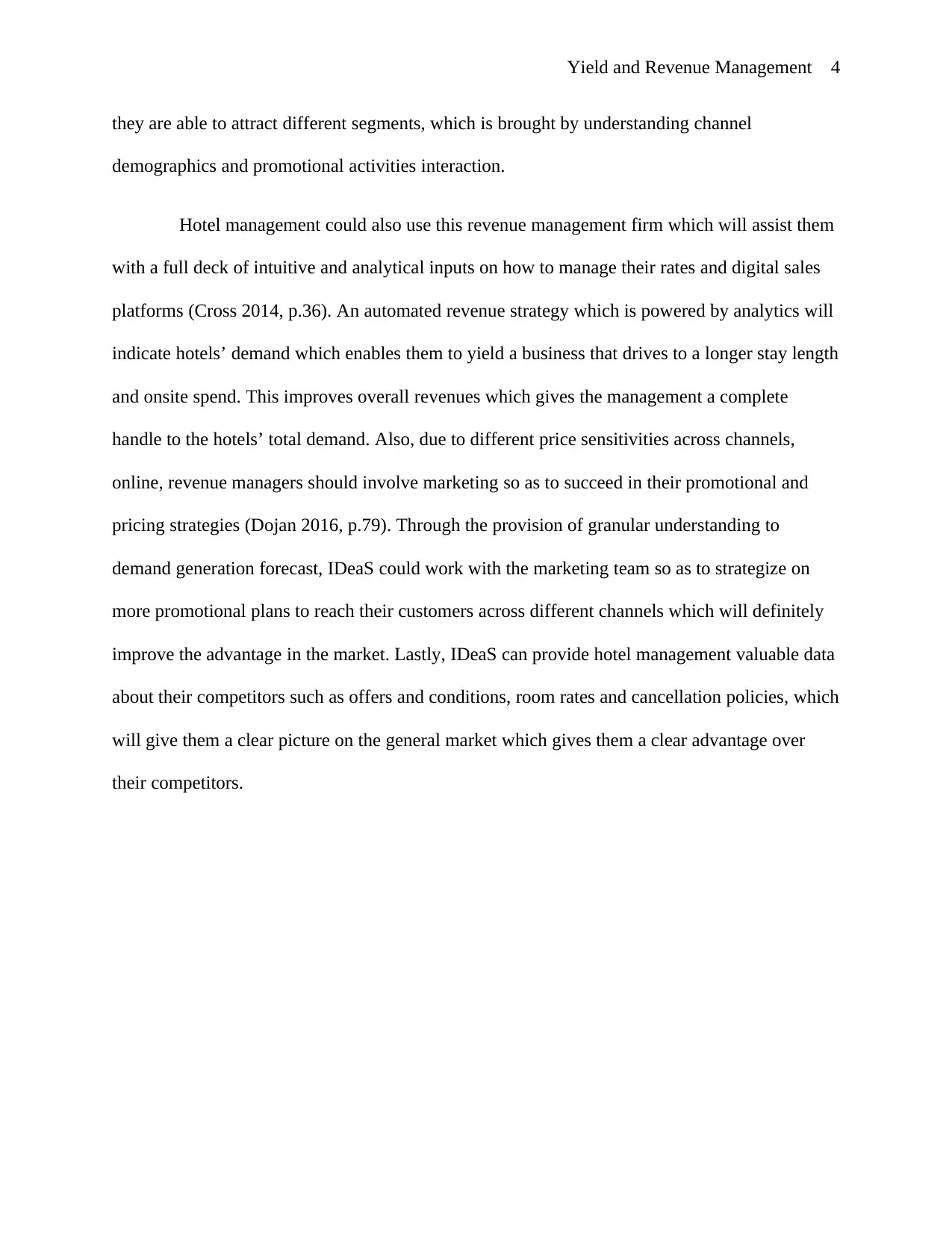
Yield and Revenue Management 4
they are able to attract different segments, which is brought by understanding channel
demographics and promotional activities interaction.
Hotel management could also use this revenue management firm which will assist them
with a full deck of intuitive and analytical inputs on how to manage their rates and digital sales
platforms (Cross 2014, p.36). An automated revenue strategy which is powered by analytics will
indicate hotels’ demand which enables them to yield a business that drives to a longer stay length
and onsite spend. This improves overall revenues which gives the management a complete
handle to the hotels’ total demand. Also, due to different price sensitivities across channels,
online, revenue managers should involve marketing so as to succeed in their promotional and
pricing strategies (Dojan 2016, p.79). Through the provision of granular understanding to
demand generation forecast, IDeaS could work with the marketing team so as to strategize on
more promotional plans to reach their customers across different channels which will definitely
improve the advantage in the market. Lastly, IDeaS can provide hotel management valuable data
about their competitors such as offers and conditions, room rates and cancellation policies, which
will give them a clear picture on the general market which gives them a clear advantage over
their competitors.
they are able to attract different segments, which is brought by understanding channel
demographics and promotional activities interaction.
Hotel management could also use this revenue management firm which will assist them
with a full deck of intuitive and analytical inputs on how to manage their rates and digital sales
platforms (Cross 2014, p.36). An automated revenue strategy which is powered by analytics will
indicate hotels’ demand which enables them to yield a business that drives to a longer stay length
and onsite spend. This improves overall revenues which gives the management a complete
handle to the hotels’ total demand. Also, due to different price sensitivities across channels,
online, revenue managers should involve marketing so as to succeed in their promotional and
pricing strategies (Dojan 2016, p.79). Through the provision of granular understanding to
demand generation forecast, IDeaS could work with the marketing team so as to strategize on
more promotional plans to reach their customers across different channels which will definitely
improve the advantage in the market. Lastly, IDeaS can provide hotel management valuable data
about their competitors such as offers and conditions, room rates and cancellation policies, which
will give them a clear picture on the general market which gives them a clear advantage over
their competitors.
Paraphrase This Document
Need a fresh take? Get an instant paraphrase of this document with our AI Paraphraser
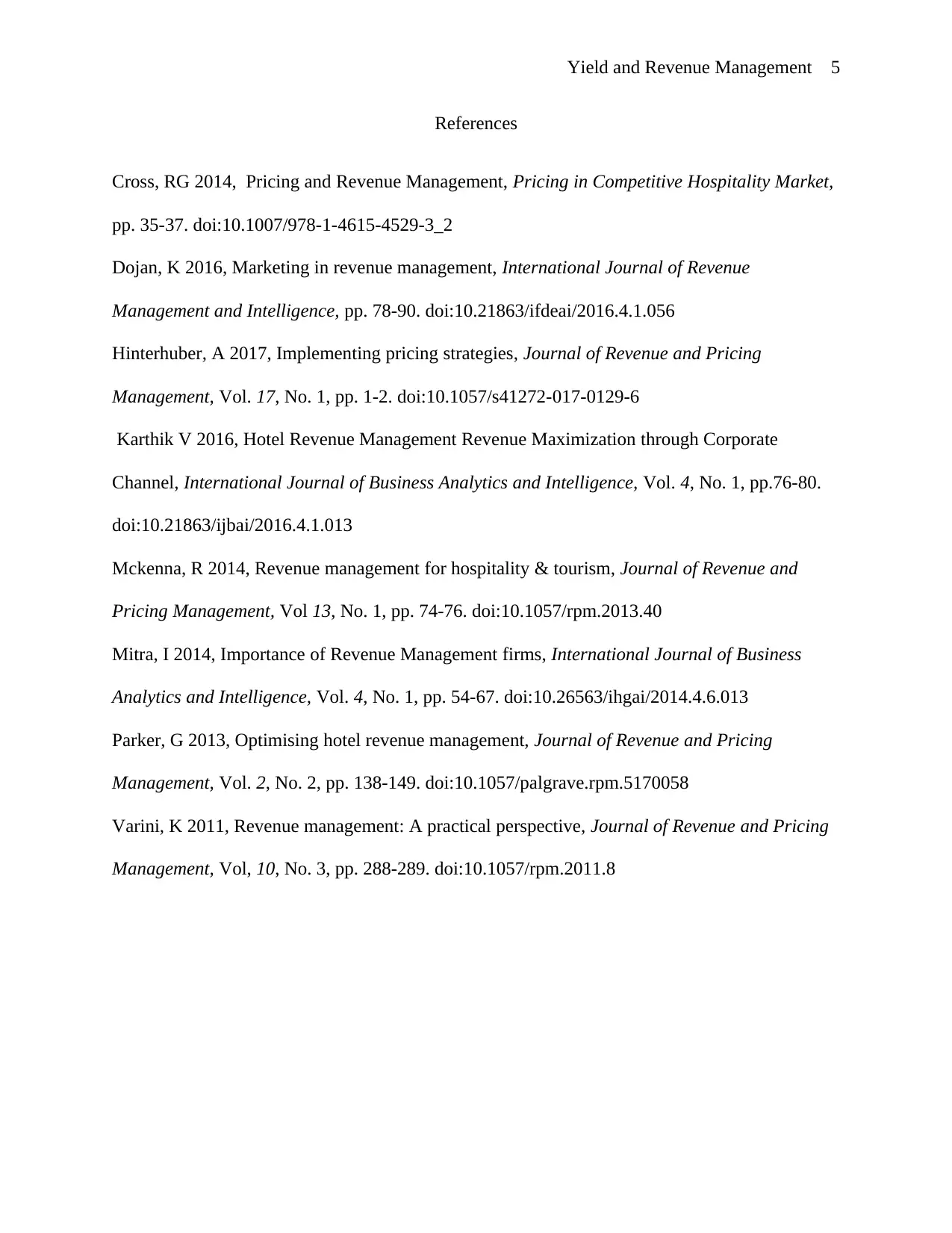
Yield and Revenue Management 5
References
Cross, RG 2014, Pricing and Revenue Management, Pricing in Competitive Hospitality Market,
pp. 35-37. doi:10.1007/978-1-4615-4529-3_2
Dojan, K 2016, Marketing in revenue management, International Journal of Revenue
Management and Intelligence, pp. 78-90. doi:10.21863/ifdeai/2016.4.1.056
Hinterhuber, A 2017, Implementing pricing strategies, Journal of Revenue and Pricing
Management, Vol. 17, No. 1, pp. 1-2. doi:10.1057/s41272-017-0129-6
Karthik V 2016, Hotel Revenue Management Revenue Maximization through Corporate
Channel, International Journal of Business Analytics and Intelligence, Vol. 4, No. 1, pp.76-80.
doi:10.21863/ijbai/2016.4.1.013
Mckenna, R 2014, Revenue management for hospitality & tourism, Journal of Revenue and
Pricing Management, Vol 13, No. 1, pp. 74-76. doi:10.1057/rpm.2013.40
Mitra, I 2014, Importance of Revenue Management firms, International Journal of Business
Analytics and Intelligence, Vol. 4, No. 1, pp. 54-67. doi:10.26563/ihgai/2014.4.6.013
Parker, G 2013, Optimising hotel revenue management, Journal of Revenue and Pricing
Management, Vol. 2, No. 2, pp. 138-149. doi:10.1057/palgrave.rpm.5170058
Varini, K 2011, Revenue management: A practical perspective, Journal of Revenue and Pricing
Management, Vol, 10, No. 3, pp. 288-289. doi:10.1057/rpm.2011.8
References
Cross, RG 2014, Pricing and Revenue Management, Pricing in Competitive Hospitality Market,
pp. 35-37. doi:10.1007/978-1-4615-4529-3_2
Dojan, K 2016, Marketing in revenue management, International Journal of Revenue
Management and Intelligence, pp. 78-90. doi:10.21863/ifdeai/2016.4.1.056
Hinterhuber, A 2017, Implementing pricing strategies, Journal of Revenue and Pricing
Management, Vol. 17, No. 1, pp. 1-2. doi:10.1057/s41272-017-0129-6
Karthik V 2016, Hotel Revenue Management Revenue Maximization through Corporate
Channel, International Journal of Business Analytics and Intelligence, Vol. 4, No. 1, pp.76-80.
doi:10.21863/ijbai/2016.4.1.013
Mckenna, R 2014, Revenue management for hospitality & tourism, Journal of Revenue and
Pricing Management, Vol 13, No. 1, pp. 74-76. doi:10.1057/rpm.2013.40
Mitra, I 2014, Importance of Revenue Management firms, International Journal of Business
Analytics and Intelligence, Vol. 4, No. 1, pp. 54-67. doi:10.26563/ihgai/2014.4.6.013
Parker, G 2013, Optimising hotel revenue management, Journal of Revenue and Pricing
Management, Vol. 2, No. 2, pp. 138-149. doi:10.1057/palgrave.rpm.5170058
Varini, K 2011, Revenue management: A practical perspective, Journal of Revenue and Pricing
Management, Vol, 10, No. 3, pp. 288-289. doi:10.1057/rpm.2011.8
1 out of 5
Related Documents
Your All-in-One AI-Powered Toolkit for Academic Success.
+13062052269
info@desklib.com
Available 24*7 on WhatsApp / Email
![[object Object]](/_next/static/media/star-bottom.7253800d.svg)
Unlock your academic potential
Copyright © 2020–2025 A2Z Services. All Rights Reserved. Developed and managed by ZUCOL.




